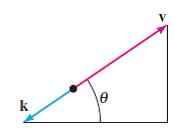(a) Now suppose that air resistance is a retarding force tangent to the path but acts opposite...
Question:
(a) Now suppose that air resistance is a retarding force tangent to the path but acts opposite to the motion. If we take air resistance to be proportional to the velocity of the projectile, then we saw in Problem 24 of Exercises 4.9 that motion of the projectile is describe by the system of linear differential equations

Where β > 0. Use the Laplace transform to solve this system subject to the initial conditions  where
where  are constant.
are constant.
(b) Suppose slug 
 Use a CAS to find the time when the projectile hits the ground and then compute its corresponding horizontal range.
Use a CAS to find the time when the projectile hits the ground and then compute its corresponding horizontal range.
(c) Repeat part (c) using the complementary angle θ = 52° and compare the range with that found in part (b). Does the property in part (c) of Problem 49 hold?
(d) Use the parametric equations and in part (a) along with the numerical data in part (b) to plot the ballistic curve of the projectile. Repeat with the same numerical data in part (b) but take θ = 52°. Superimpose both curves on the same coordinate system. Compare these curves with those obtained in part (e) of Problem 49.
(reference exercise 4.9 of problem 24)
Exercise 4.9
Determine a system of differential equations that describes the path of motion in Problem 23 if air resistance is a retarding force k (of magnitude k) acting tangent to the path of the projectile but opposite to its motion. See Figure 4.9.3. Solve the system. k is a multiple of velocity, say βv.

Step by Step Answer:

A First Course in Differential Equations with Modeling Applications
ISBN: 978-1111827052
10th edition
Authors: Dennis G. Zill





